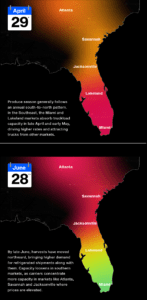Produce season is upon us, and you don’t have to be hauling food to feel its effects. It’s a time of year when demand for trucks is near its highest. And when demand rises, rates follow.
That’s why this is a time of year most carriers look forward to, especially when freight markets have been in a down cycle like they have been for the past several months. And when it comes to produce harvests, not only does the demand for trucks rise (especially for reefers), there’s urgency to get those loads where they need to be before the crops go bad. That extra urgency puts even more pressure on rates to go up.
That said, the intensity of produce season varies from year to year. For instance, droughts in California led to the 2022 produce season being more muted than most. There are signs of recovery on the West Coast though.
The exact timing of produce season also varies, but it does follow a typical pattern. Luckily, there are tools carriers can put to use to make sure they maximize their opportunities.
Produce season’s migration
In the Southeast, produce season kicks off in Southern Florida in April and moves north to Atlanta by June. That same north-to-south pattern plays out in other regions, with demand heating up when the weather does.
This can have dramatic effects on trucking lanes. Take Atlanta to Miami, for example. For 11 months out of the year, the southbound lane pays much more on average than the northbound trip from Miami to Atlanta. But in May, those roles can flip, with reefer rates for loads going from Miami to Atlanta paying more than the Atlanta to Miami trip.

How to take advantage of produce season
While many produce shipments can be handled with a dry van or vented trailer, the demand increases for reefers the most. And produce carriers will need to make sure they have the right equipment and insurance. High value loads will require fairly new reefer trailers and adequate insurance coverage.
DAT One also offers plenty of tools to help carriers take advantage of produce shipping season.
Market Conditions: Make sure you strike while the iron’s hot. With the Market Conditions map in DAT One, you can see at a glance exactly where demand is highest for trucks. Just as important, you can also see when the produce shipping season is starting to cool in a market so you don’t get caught off guard.
Quick Rate Lookup: Make sure you aren’t leaving money on the table when lane rates change drastically. Track these movements using the Quick Rate Lookup tool in the DAT One app. This shows you the two-week average rate on a lane so you can make sure you aren’t leaving any money on the table when negotiating with brokers.
Truck posts: Posting your available truck can be especially useful in markets where demand is high. DAT One also allows you to include a rate when you post your truck, so you can use the information you learned from the Market Conditions map and Quick Rate Lookup to inform your prices. Once your truck is posted, brokers can call you with loads they need moved rather than the other way around.
TriHaul: Even with produce season upon us, we’re still in a down market overall, so planning your routes for maximum profitability can still be a challenge. With the TriHaul tool in DAT One, you get automatic suggestions for triangular routes, where adding an extra stop could boost your revenue compared to a typical there-and-back roundtrip.
Learn more about how DAT One can help grow your business for the long haul

